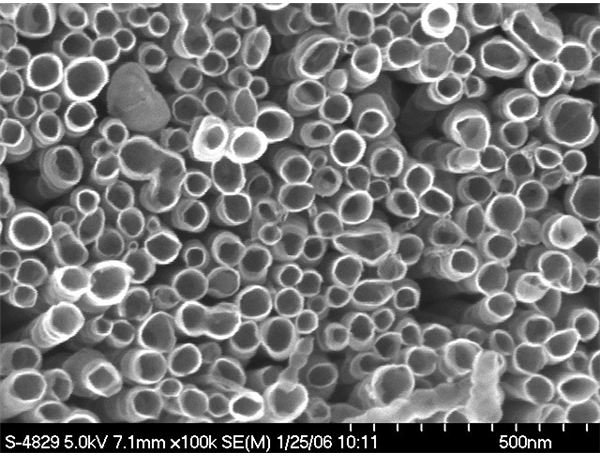Self-Replicating Nanotubes - Research and Implications
Carbon nanotubes are cylindrical structures consisting of carbon molecules. Although their diameter is in the order of a few nanometers, they may reach several millimeters in length. They are mostly valued for their extraordinary mechanical, thermal, and electrical properties. In particular, the discrete separation of the carbon nanotube energy levels is the reason for their excellent semiconducting properties. They also exhibit unique stiffness and strength, and can be used in a variety of applications such as the manufacturing of electronic circuits, materials, optics, batteries, solar cells, textiles, and many more.
In general, nanotubes can be found in two types: single-walled (SWNTs), consisting of only one graphitic layer, and multi-walled (MWNTs) consisting of multiple concentric graphitic layers.
The Process of Self-Assembly
There are various methods for the synthesis of nanotubes in large quantities, including arc discharge, laser ablation, chemical vapor deposition, and others. However, there is also a smaller scale process that can take place without any external stimulation. It is known as molecular self-assembly, where molecules can be arranged in well-defined patterns without human intervention. The same process can be applied to nanotubes as well.
Researchers have achieved the right experimental conditions and mix of catalysts to reproduce the self-assembling of nanotubes, in the same way that the deoxyribonucleic acid or DNA does. Carbon molecules are then linking in groups of six to form rosette-shaped rings and the rings, in their turn, assemble to create rod-like nanotubes. The result is the formation of self-replicating nanotubes that can be regarded as a superior material for multiple applications.
Such experiments have already taken place in recent years, regarding the creation of artificial joints, body implants and electronic device applications. The results, although at an experimental level, were very promising.

Fabrics and Other Applications

Apart from the wide application potential in biomedical fields, a recent development also involves the production of a perfectly uniform layer of self-assembled nanotubes known as “nanocarpet.” When magnified a million times, the nanocarpet structure resembles the fibers of a shag rug. These tiny carpets are used as thermal interface materials in chips to protect them from overheating. They also have the ability to sense their environment by modifying their color according to the environmental conditions and even detect and kill bacteria (such as E. coli). Other possible applications include the detection and decontamination of chemical and biological weapons.
Electronic textiles or fabrics are another major field where nanotubes could be used more extensively. The process is simple: a cotton thread is being coated with conductive carbon nanotubes and then can be woven into fabric. These threads can conduct a significant amount of electric current, so that a LED attached to them, can shine brightly enough. It has been observed that these nanotube textiles demonstrate interesting biosensing abilities, such as sensing human blood.
Fears, Speculation, and Reality
An undeniable number of benefits are likely to be acquired through the use of self-assembling nanotubes as a raw material. They are inexpensive (as they are made of carbon), and since they can replicate in room-temperature conditions within a few hours, they have the additional advantage of low production costs.
According to popular belief however, these developments may prove quite risky. (See “Is Nanotechnology in Fuel Cells Ultimately Bad for the Environment?”) Self-assembling nanotube structures could “go wild,” as the fearful theory goes, and replicate uncontrollably in the field. The possible consequences are only limited by our imagination.
Although concerns like this are always expected when new technologies are tested, there is no solid proof yet that could possibly justify them. The self-assembling phenomenon has only been observed under certain conditions- even without human help- and are limited to the nano-scale. Despite the concerns, this is a first and important step toward the design of novel nanostructured materials with unlimited application potential.
Sources:
- _“Self assembly of carbon nanotubes (CNTs)” , “_Carbon Nanotubes for electronic textile applications” by NanotechnologyDevelopment.Com
- “Self-assembling ’nanotubes’ offer promise for future artificial joints” by NanotechWire.Com
- “Carbon nanotube” ScienceDaily.Com
- “Self-Assembling Nanotubes Change Colors, Form ‘Nanocarpet’ and Even Kill Bacteria” mirm.pitt.edu
Image Credits:
- This is an STM Atomically Resolved Image Showing the Structure of a Nanotube by Taner Yildirim
- The Structure of a Carbon Nanotube by Guillaume Paumier
- Aligned Carbon Nanotubes by Argonne National Laboratory
